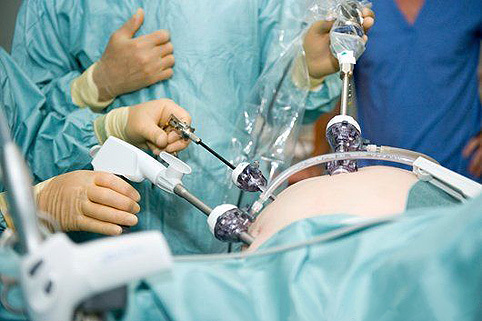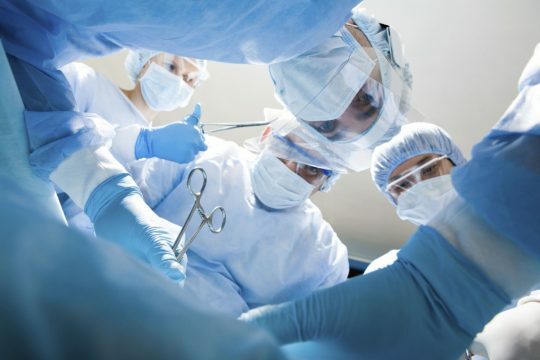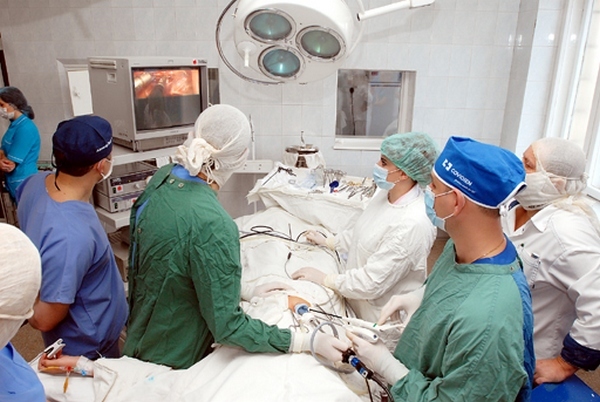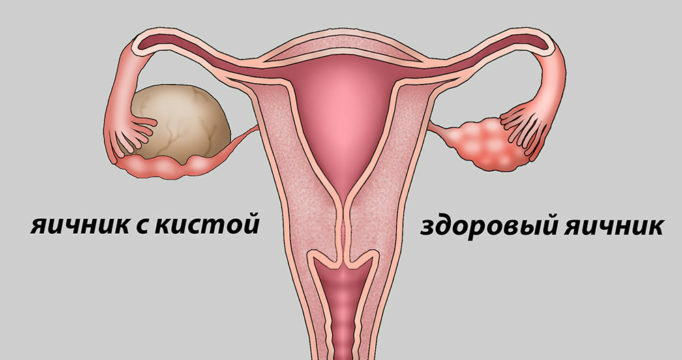Laparoscopy is a diagnostic and therapeutic procedure common in modern medicine, used in the treatment or examination of organs located in the abdominal cavity. This minimally invasive method greatly facilitates the work of doctors, since no matter how high the doctor's qualification, however great his experience, the diagnosis of diseases and pathological foci in the pelvic region and peritoneum is complicated. In gynecology, laparoscopy for polycystic ovaries helps not only to put an accurate diagnosis on time, but also to conduct surgical treatment that is more effective and sparing than the methods that existed before.
What is the method of

laparoscopy? Laparoscopy refers to the surgical procedure, since for its carrying out it is necessary to cut the abdominal wall in one or two( rarely more) places. In one of the sections a tool called a laparoscope is inserted. It is a very thin optical tube with a lens at one end and an eyepiece on the other. Also, a laparoscope can be equipped with a tiny video camera that will transmit to the monitor an image of the organs and the abdominal cavity itself. If necessary, through a different incision, a tool is introduced to perform the necessary manipulations in this case.
The length of the incisions is several millimeters, they can be compared with punctures of a large diameter needle. This provides an excellent cosmetic effect compared to other surgical methods, in which the length of the incisions is much greater, and the remaining even the most accurate seams still do not satisfy the woman from an aesthetic point of view. Especially it concerns a laparotomy - revision of organs of an abdominal cavity through a wide cut.
The technology of laparoscopy is such that a physician can perform a complete examination of all organs, practically without breaking the integrity of the abdominal wall, and in some cases also carry out treatment with the use of minimally invasive techniques. To improve the quality of visibility and to facilitate revision in the abdominal cavity, the required amount of carbon dioxide is pumped through the incision through the incision - the stomach is "pumped up", thereby increasing the volume of the peritoneum, which provides the doctor with greater operational space and better vision.
Laparoscopy for polycystic ovary syndrome
In gynecology, polycystosis is diagnosed in every tenth woman who seeks a doctor for infertility. Treatment of multifollicularity of the ovaries with the help of conservative methods is not always successful, and the old methods of surgical treatment are traumatic.
Laparoscopy in polycystic ovaries allows not only to diagnose the disease with high accuracy, but also to remove multiple cysts and restore the normal functioning of the organs.
Depending on the condition of the ovaries, certain laparoscopic interventions can be performed:
- decortication,
- cauterization,
- endothermocoagulation,
- electrilling,
- wedge resection.
For all these operations, the cystic-altered follicles are removed and conditions for ovulation are created.
Decoration of

For this surgical procedure, along with a laparoscope, an acicular electrode is inserted into the abdominal cavity, with which a dense outer layer is removed from the ovaries, in which androgen is intensively produced. It is this sclerotic protein shell that prevents the egg from leaving the ovary, since the follicle can not normally grow and fully mature, and the follicular cavity wall can not burst, leaving a mature egg inside the ovary. Puncture of the cystically-altered follicles is also performed. After such a laparoscopic operation, the mature ovum unhindered beyond the follicular cavity.
Cauterization of
This operation is prescribed when there is no possibility of forming normal follicles in the ovarian tissue. When cauterizing a cut in the abdominal wall, a special microsurgical instrument is inserted, with the help of which the doctor makes a few( from six to eight) circular incisions on the ovary, the depth of which is 1 centimeter. This is done so that after the operation in the places where the radial incisions were made, a new tissue grew, healthy. It will grow and mature the "right" follicles.
Vaginal resection
This laparoscopic operation is prescribed in cases where in the syndrome of polycystic ovaries it is necessary to facilitate the release of a healthy egg from an overgrown ovary. This resection is used if the tissue grows excessively, up to two-thirds of the volume. To do this, a small wedge-shaped particle of tissue is excised from the pole of the ovary in such a way that the ovarian tissue is touched minimally, and the larger the capsular tissue is cut. The use of an electron knife with this procedure is limited. After the sphenoid resection, auxiliary hormone therapy is appointed to restore the reproductive function. This method is used less often than others, as compared to other methods, it is more traumatic.
Endotermocoagulation
With the help of laparoscopy, an electrode is inserted into the tissue of the ovaries to a depth of centimeter, which burns out miniature holes in the body of the organ at a small( about 10 cm) distance from each other. In total, no more than 15 moxibustions are done. This procedure helps to stop the increased production of androgens in the ovaries. This operation is less traumatic than a clinic resection.
Electrodrilling

The essence of electrilling consists in superficial cauterization and, accordingly, removal by the electric current of multiple cysts on the ovaries. Also, small holes are made by the drilling method in the compacted protein coat of the ovaries, after which the exit from the follicle of the mature egg is facilitated.
What to do before laparoscopy
Before a laparoscopic operation it is necessary to undergo a number of examinations, including:
- to pass blood tests( clinical), feces and urine( general),
- to make a fluorography,
- to do an electrocardiogram,
- to undergo ultrasound of the pelvic organs.
It is recommended not to eat eight hours before surgery.
The therapist should give an opinion on the absence of contraindications to this surgical intervention.
When laparoscopy is contraindicated to
Contraindications to this operation may be absolute and relative. To absolute are:
- coma and other terminal conditions,
- cardiopulmonary pathology,
- purulent peritonitis.
Relative contraindications:
- III-IV degree of obesity,
- increased or decreased blood clotting,
- pregnancy in later stages,
- general inflammation and infection,
- history of abdominal operations performed in the last 3 months.
What to do after laparoscopy
After laparoscopy of the ovaries in case of polycystosis the woman should be in the hospital for the first day under the supervision of doctors. Longer stay in a medical institution is inexpedient: laparoscopy refers to low-traumatic operations, bed rest after it is not required, as well as anesthesia with the help of strong drugs.
But a number of precautions should be followed, including:
- to avoid excessive physical exertion,
- to exclude the thermal effect on the ovarian region.
If after the procedure you have soreness in the ovary or if the fever keeps for a few days, you need to see a doctor. Self-medication can lead to serious consequences.



